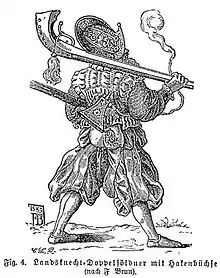Doppelsöldner
Doppelsöldner ("double-mercenaries", "double-pay men",[1] from German doppel- meaning double, Sold meaning pay) were Landsknechte in 16th-century Germany who volunteered to fight in the front line, taking on extra risk, in exchange for double payment. The stated ratio was that one Landsknecht in four would be a Doppelsöldner. The Doppelsöldner of each company were usually issued with ranged weapons, such as a crossbow or an arquebus, and arranged in the wings of a square, in front of the pikemen.[2]

Likewise, Landsknechte schooled in the use of the Zweihänder (two-hander), a two-handed sword, were entitled to double pay and thus qualified as Doppelsöldner.[3] The fencing guild of the Brotherhood of St. Mark had the monopoly on the use of the Zweihänder after Frederick III, Holy Roman Emperor granted it to them in 1487.
The Zweihänder was allegedly used by the Doppelsöldner to break through formations of pikemen, especially Swiss pikemen, by either being swung to break the ends of the pikes themselves or to knock them aside and attack the pikemen directly. The veracity of this tradition is disputed, but at least as a legend, it appears to date to at least the 17th century.
See also
References
- Elting, John (2009). Swords Around a Throne. Da Capo Press. p. 712. ISBN 978-0-7867-4831-0.
- Rogers, Cliff (2010). The Oxford Encyclopedia of Medieval Warfare and Military Technology. 1. Oxford University Press. ISBN 978-0195334036.
- Clements, J. "The Weighty Issue of Two-Handed Greatswords". ARMA. Retrieved 11 May 2012.
Further reading
- Douglas Miller, John Richards: Landsknechte. 1486–1560. Siegler, Sankt Augustin 2004, ISBN 3-87748-636-3.
- Thomas Arnold: The Renaissance at War. Cassell, London 2002, ISBN 0-304-36353-7.
- Sebastian Franck: Chronica des gantzen Teutschen lands, aller Teütschen völcker herkom(m)en, Namen, Händeln, Guten vn(n) (unn) bösen Thaten [...]. Apiario, Bern 1539. (auch Germaniae chronicon. 1538)